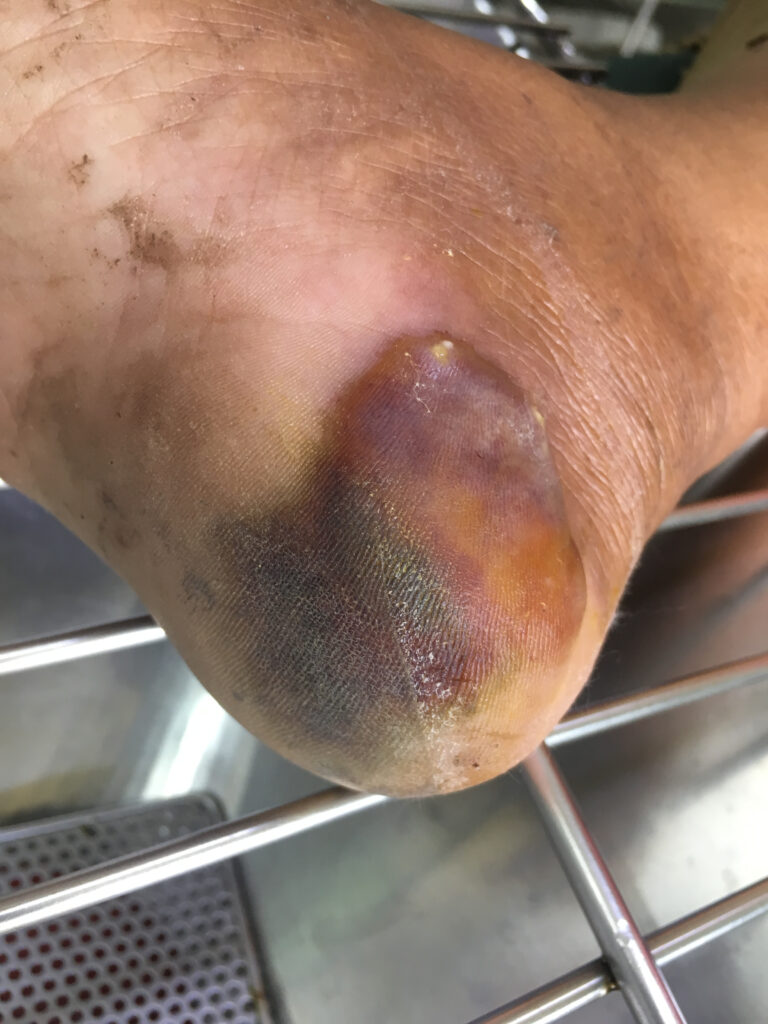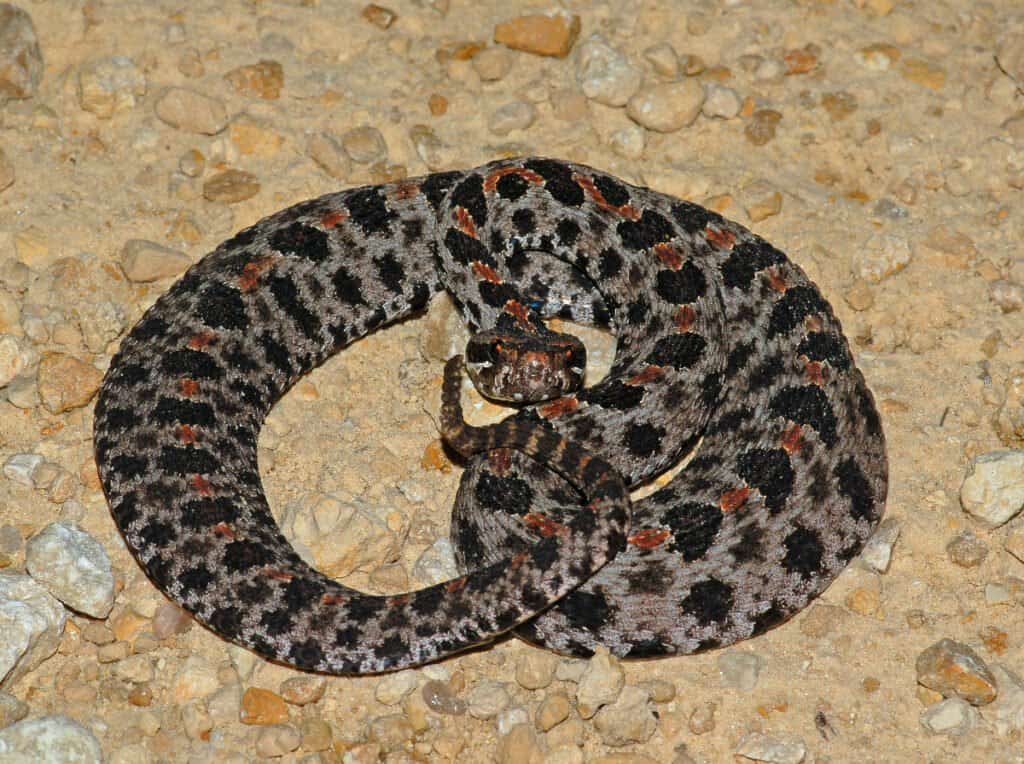Missouri has a good climate for people and wildlife, including snakes. In fact, there are at least 49 species and subspecies of snakes in Missouri, including five venomous ones: the Osage copperhead, western cottonmouth, timber rattlesnake, eastern massasauga rattlesnake, and the pygmy rattlesnake. This article focuses on one of the most feared snakes: the rattlesnake. When are Missouri rattlesnakes most active? How can you keep yourself and your pets safe from them? And how do you treat a rattlesnake bite? Read on for answers to these questions!

Rattlesnake bites usually happen when someone steps on one by accident or tries to handle or kill one.
©Chuanpit/Shutterstock.com
Why Do Snakes Love Missouri?
Snakes love Missouri for some of the same reasons people do: it has a great climate, a wide variety of unspoiled natural land, and it’s not overcrowded with people. Missouri has prairies, hills and valleys, swamps, wetlands – really anything a snake, and the animals a snake eats, could want. As a result, the state hosts 49 different species and subspecies of snake. Most of them are harmless, but that number does include five venomous snakes: the osage copperhead, western cottonmouth, timber rattlesnake, eastern massasauga rattlesnake, and the pygmy rattlesnake.
Because snakes are cold-blooded reptiles, they cannot regulate their own body temperature internally. They need to lay out and sun themselves on rocks when they’re cold and retreat to the shade when they get too hot. In the winter they go into a state of semi-dormancy that is not a full hibernation, but close to it. Given these needs and the climate in Missouri, rattlesnakes are most active there in the spring, starting around mid-April, and the fall, around mid-October. So basically, during the nice weather when you might want to be out hiking or camping, yourself. That’s a bummer but read on and let’s see how to keep you safe.

The same unspoiled wild areas and moderate climate that attract people to the state also make it an ideal environment for snakes.
©Steven Schremp/Shutterstock.com
Rattlesnake Basics
Regardless of the exact species, you can always tell a snake is a rattlesnake if it has a triangular-shaped head with a couple of pits on either side of its nose and a rattle on the end of its tail. Those pits make these snakes a kind of pit viper. They help them locate prey based on body heat. Rattlesnakes eat mice, rats, rabbits, squirrels, birds, and other small animals. Their venom is intended to immobilize their prey so they can eat it. Rattlesnakes are born live and are venomous from their first moments of life.
Like most snakes, rattlesnakes would prefer to get away from people or anything else that is much bigger than them and could hurt them. However, if they are surprised or someone deliberately tries to handle them, poke them, or kill them, they will defend themselves. Their warning rattle is their first line of defense. The snake’s rattles are made of the same thing as your fingernails: keratin. They’re born with a little button and add another segment onto it to make a longer rattle each time they shed their skin, until it’s up to eight to 13 segments long. The rattle segments are hollow and the buzzing sound they make is just from them being shaken together extremely fast.
Warning

Rattlesnakes add a new segment to their rattles with each shedding of their skin. This can help you tell how old the snake is.
©Chase D’animulls/Shutterstock.com
If their warning noise doesn’t scare off the threat, the rattlesnake may strike up to 2/3 of its body length. So a 3-foot-long snake can strike up to two feet away. Rattlesnake fangs fold back when they shut their mouths. It’s possible for them to bite without injecting venom. This is called a “dry bite.” It takes a lot of energy to produce venom and the snake doesn’t want to waste it. About 25% of all bites are dry bites. Some people have mistakenly believed that they were immune to rattlesnake venom because they have experienced a dry bite, and this is a deadly mistake to make. If that person later is fully envenomated by a timber rattlesnake, for example, and does not get treatment, they can begin to experience organ failure and die in two-three days. Every bite must be assumed to be venomous and treated by a medical professional, however, as it would not be possible for a bite victim to know.

A rattlesnake can strike up to 2/3 the length of its body away.
©Maria Dryfhout/Shutterstock.com
Which is the Most Venomous?
Let’s make sure we use the right terminology. If something bites you and you get sick or die, it was venomous. If you bite something and you get sick or die, it was poisonous. So, certain kinds of snakes are venomous, and certain kinds of mushrooms are poisonous. Now that we have that out of the way, of the venomous snake species in Missouri, which is the most venomous? The answer is the rattlesnake. Their venom is much more dangerous and fast-acting than either copperhead or cottonmouth venom. Here are descriptions of the three types of rattlesnakes in Missouri:
Timber Rattlesnake
Timber rattlesnakes (Crotalus horridus) grow 3-5 feet long and weigh from one to three pounds. Their bite is considered highly toxic. They have a pattern of dark brown or black bands on their backs on a background of yellowish-brown or grey. Sometimes they can be almost solid black. This is the most dangerous of the three species because it is large, produces a lot of venom, and has long fangs to inject it.

Timber rattlesnakes are the largest and most dangerous rattlesnake species in Missouri.
©Frode Jacobsen/Shutterstock.com
Massasauga Rattlesnake
Massasauga rattlesnakes (Sistrurus catenatus) grow to be 2-3 feet long and weigh less than a pound. Most rattlesnakes have rattles about eight segments long, but these may have as many as 13. Their venom is highly toxic but their fangs are really short so they cannot inject very much. This makes them more dangerous to children and elderly people than to healthy human adults. Their color can range from gray to light brown to black with brown or black spots on their back and sides.

The massasauga rattlesnake (
Sistrurus catenatus catenatus) has a pattern of spots or splotches of dark color on its back and sides.
©Ryan M. Bolton/Shutterstock.com
The Pygmy Rattlesnake
The pygmy rattlesnake (Sistrurus miliarius) is the smallest rattlesnake species in the United States, growing to be only 18-24 inches long and weighing about 5.4 ounces. Their body color can be light or dark gray. They have a black nose and small rattles on the end of their tail. They are venomous but are not as dangerous as most other rattlesnake species because they do not produce very much venom.

The pygmy rattlesnake has a small, thick body. Although it is venomous, its fangs are short, and it does not produce much venom.
©Gerald A. DeBoer/Shutterstock.com
How to Avoid a Rattlesnake Bite
When Missouri rattlesnakes are most active, here are some things you can do to protect yourself and your pets:
- Do not try to pick up, poke, or kill a rattlesnake. This is when bites happen.
- Be especially alert for the possibility of snakes in the spring and fall.
- Carry a walking stick to help make noise ahead of you as you walk, to tap the trail and to stir up leaves. If snakes hear you coming, they will get out of the way.
- Stay on marked trails. Do not walk through underbrush or thick grass.
- Don’t walk in the dark when snakes may be hunting.
- Wear solid boots or shoes with closed toes and long pants when walking.
- When camping, shake out sleeping bags, clothes, and shoes.
- If you are going to move a log or a big rock, roll it toward you so anything beneath it can move in the opposite direction.
- Don’t put your hands or feet anyplace you can’t see.
- Avoid areas where you have seen snakeskin. If you hear a rattling sound, then go in the opposite direction.
- Be aware that rattlesnakes can and do swim.
- If you find a dead rattlesnake, do not allow your kids or pets to go near it, even if the head is completely severed. A severed head can continue to bite reflexively for hours after a snake has died and can inject venom.
- Keep the grass in your yard clipped short, vegetation minimal, and brush piles removed.
- Keep your dogs on a leash and don’t allow them to wander off-trail where they could be bitten.

During rattlesnake season, avoid walking off-trail and keep your dog on a leash.
©Christian Mueller/Shutterstock.com
First Aid for a Rattlesnake Bite
- Stay calm and call 911 or use a radio to call for help.
- Don’t make cuts at the site of the bite wound or try to suck the poison out with your mouth.
- Don’t use a tourniquet.
- Don’t apply ice.
- Just rinse it off with soap and clean water.
- If the person got bitten on the hand or arm, remove watches, bracelets, or rings so they don’t have to be cut free later as a result of swelling.
- Keep the person still and keep the bite below the level of the heart.
- Wait for an ambulance or drive safely to the nearest medical facility. Do not drive at high speeds because this will raise the victim’s heart rate and could cause an accident that will delay treatment.
- If the bite happened to a dog or other animal, get them to an emergency vet as soon as possible.
About 800 people a year are bitten by rattlesnakes, but fewer than a dozen die of it. Some of these are dry bites, but even when venom is injected, victims who get medical care right away, including an antivenom injection, can recover within two to three days. More people die from an allergic reaction to bees than from snake bites. So, just take some reasonable precautions and you and the snakes can both enjoy your separate spaces in Missouri.
The photo featured at the top of this post is © Scott Delony/Shutterstock.com
Discover the "Monster" Snake 5X Bigger than an Anaconda
Every day A-Z Animals sends out some of the most incredible facts in the world from our free newsletter. Want to discover the 10 most beautiful snakes in the world, a "snake island" where you're never more than 3 feet from danger, or a "monster" snake 5X larger than an anaconda? Then sign up right now and you'll start receiving our daily newsletter absolutely free.
Thank you for reading! Have some feedback for us? Contact the AZ Animals editorial team.






